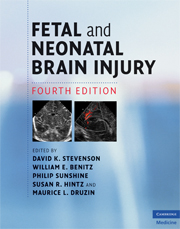Book contents
- Frontmatter
- Contents
- List of contributors
- Foreword
- Preface
- Section 1 Epidemiology, pathophysiology, and pathogenesis of fetal and neonatal brain injury
- Section 2 Pregnancy, labor, and delivery complications causing brain injury
- Section 3 Diagnosis of the infant with brain injury
- Section 4 Specific conditions associated with fetal and neonatal brain injury
- 22 Congenital malformations of the brain
- 23 Neurogenetic disorders of the brain
- 24 Hemorrhagic lesions of the central nervous system
- 25 Neonatal stroke
- 26 Hypoglycemia in the neonate
- 27 Hyperbilirubinemia and kernicterus
- 28 Polycythemia and fetal–maternal bleeding
- 29 Hydrops fetalis
- 30 Bacterial sepsis in the neonate
- 31 Neonatal bacterial meningitis
- 32 Neurological sequelae of congenital perinatal infection
- 33 Perinatal human immunodeficiency virus infection
- 34 Inborn errors of metabolism with features of hypoxic–ischemic encephalopathy
- 35 Acidosis and alkalosis
- 36 Meconium staining and the meconium aspiration syndrome
- 37 Persistent pulmonary hypertension of the newborn
- 38 Pediatric cardiac surgery: relevance to fetal and neonatal brain injury
- Section 5 Management of the depressed or neurologically dysfunctional neonate
- Section 6 Assessing outcome of the brain-injured infant
- Index
- Plate section
- References
22 - Congenital malformations of the brain
from Section 4 - Specific conditions associated with fetal and neonatal brain injury
Published online by Cambridge University Press: 12 January 2010
- Frontmatter
- Contents
- List of contributors
- Foreword
- Preface
- Section 1 Epidemiology, pathophysiology, and pathogenesis of fetal and neonatal brain injury
- Section 2 Pregnancy, labor, and delivery complications causing brain injury
- Section 3 Diagnosis of the infant with brain injury
- Section 4 Specific conditions associated with fetal and neonatal brain injury
- 22 Congenital malformations of the brain
- 23 Neurogenetic disorders of the brain
- 24 Hemorrhagic lesions of the central nervous system
- 25 Neonatal stroke
- 26 Hypoglycemia in the neonate
- 27 Hyperbilirubinemia and kernicterus
- 28 Polycythemia and fetal–maternal bleeding
- 29 Hydrops fetalis
- 30 Bacterial sepsis in the neonate
- 31 Neonatal bacterial meningitis
- 32 Neurological sequelae of congenital perinatal infection
- 33 Perinatal human immunodeficiency virus infection
- 34 Inborn errors of metabolism with features of hypoxic–ischemic encephalopathy
- 35 Acidosis and alkalosis
- 36 Meconium staining and the meconium aspiration syndrome
- 37 Persistent pulmonary hypertension of the newborn
- 38 Pediatric cardiac surgery: relevance to fetal and neonatal brain injury
- Section 5 Management of the depressed or neurologically dysfunctional neonate
- Section 6 Assessing outcome of the brain-injured infant
- Index
- Plate section
- References
Summary
Introduction
This chapter focuses on some of the more common brain malformations that are encountered early in life. Tremendous advances in neuroimaging with MRI in the past two decades have significantly improved our ability to diagnose brain malformations. In conjunction, there have been rapid advances in neurobiology that have led to better understanding of how the brain develops and what disturbances to the development lead to malformation. Each year more and more genes responsible for malformations are being discovered. Furthermore, modern fetal ultrasonography and more recently fetal MRI have increased the ability to detect a large variety of central nervous system malformations in utero. Prenatal detection and anatomic diagnosis of the malformations will better allow the medical caregivers to provide prognosis and management counseling.
Normal brain development
A brief overview of normal embryonic and fetal brain development will help to clarify the timing and etiology of brain malformations. Normal human brain development occurs in a highly defined spatial and temporal sequence of events in utero (Table 22.1). The temporal sequence consists of several overlapping phases. During the induction phase, signals sent to the ectoderm cause it to develop into neural tissue. The neural plate, a sheet of cells that will ultimately develop into the nervous system, develops by the 17th to 20th day of gestation. Neurulation occurs next, where the neural plate begins to fold into the neural tube, a process that begins by the 21st day.
- Type
- Chapter
- Information
- Fetal and Neonatal Brain Injury , pp. 265 - 276Publisher: Cambridge University PressPrint publication year: 2009



